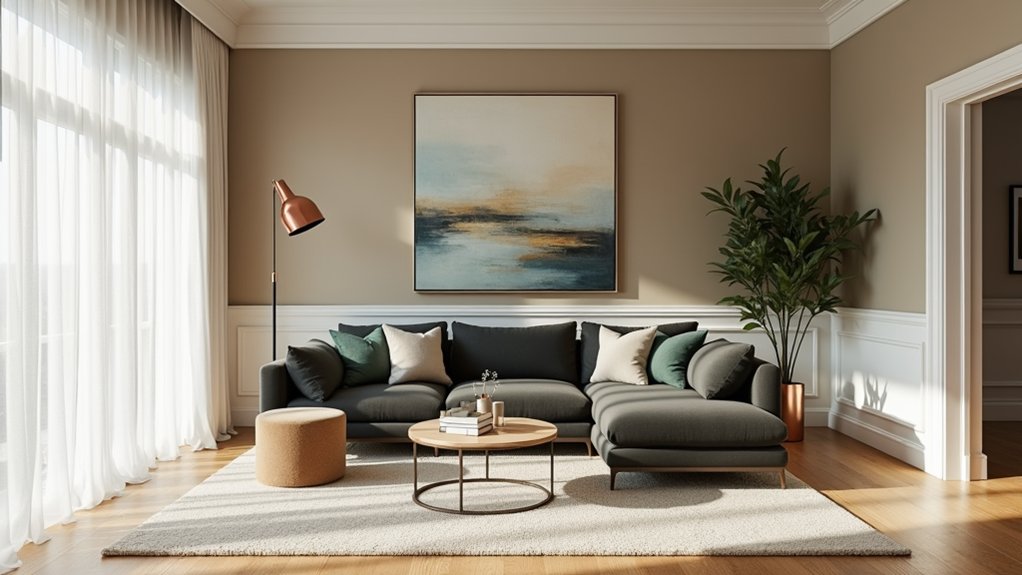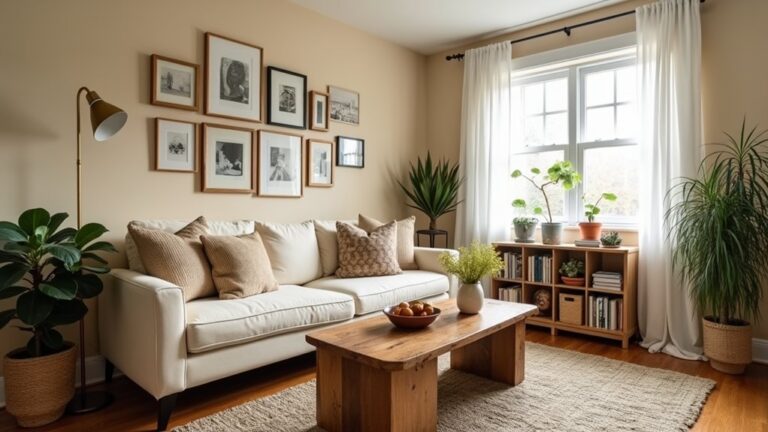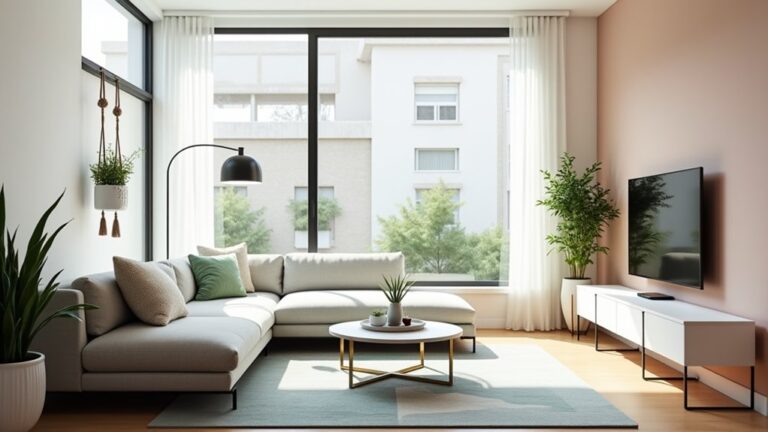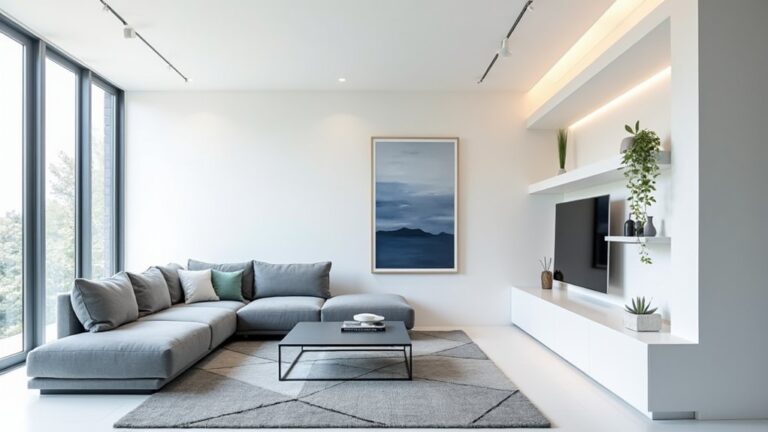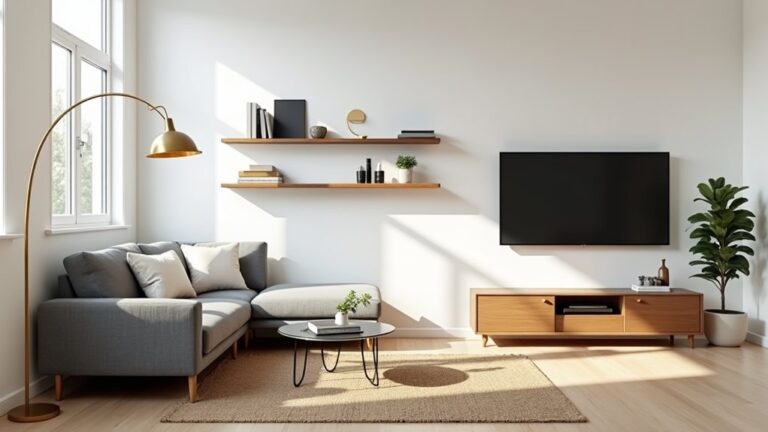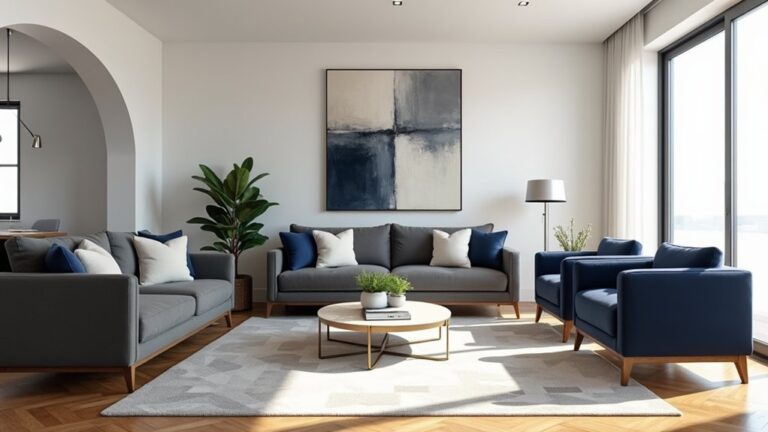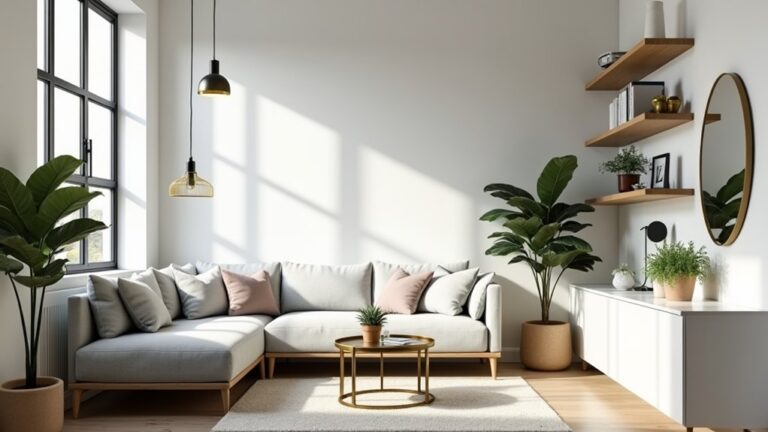Choosing living room colors requires a strategic blend of science and style. Start by evaluating natural light conditions, as north-facing rooms benefit from warm tones while south-facing spaces offer more flexibility. Establish a foundation with timeless neutrals, then implement the 60-30-10 rule: 60% dominant color, 30% secondary shades, and 10% accent hues. Consider your focal points, existing furniture, and personal color preferences while maintaining flow between connected spaces. Test paint samples under various lighting conditions and observe how colors shift throughout the day. The perfect palette balances emotional impact with practical functionality – discover how these elements work together to transform your space.
Key Takeaways
- Test paint samples on multiple walls and observe them throughout the day to understand how lighting affects color appearance.
- Follow the 60-30-10 rule, using 60% dominant color, 30% secondary colors, and 10% accent colors for balanced design.
- Consider the room's natural light direction, as north-facing rooms benefit from warm colors while south-facing spaces allow more flexibility.
- Use existing artwork, statement pieces, or focal points in the room as inspiration for your color palette selection.
- Start with neutral foundations like beige, gray, or cream to create flexibility for future design changes and seasonal updates.
Consider Natural Light First
Before selecting your living room color palette, assess the amount and quality of natural light your space receives throughout the day.
Rooms facing north tend to receive cooler color temperature light, making warm paint colors ideal to balance the space. South-facing rooms benefit from natural illumination that reveals true color values, allowing for greater flexibility in color selection.
Consider installing daylight-mimicking bulbs to create optimal lighting conditions in spaces with limited natural light exposure.
Start With Neutral Colors
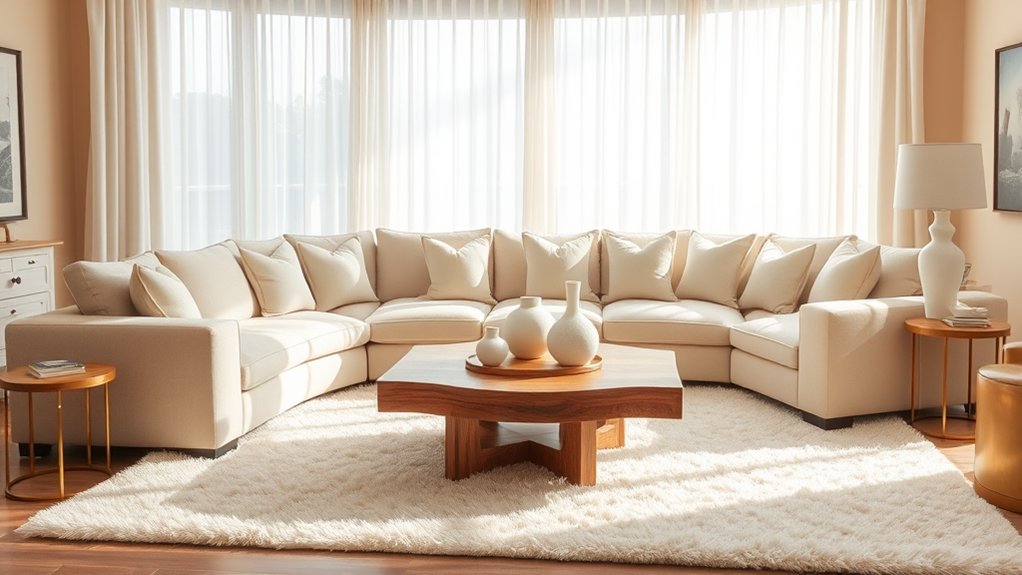
Neutral colors establish a timeless foundation for any living room design scheme.
Shades of beige, gray, cream, and white create versatile backdrops that accommodate evolving interior design preferences.
These understated color schemes allow for effortless updates through accent pieces and seasonal decor.
Professional designers often recommend starting with neutrals to guarantee long-term design flexibility and visual harmony.
Following the 60-30-10 rule helps balance your dominant neutral tones with secondary and accent colors while maintaining visual interest.
Use The 60-30-10 Rule
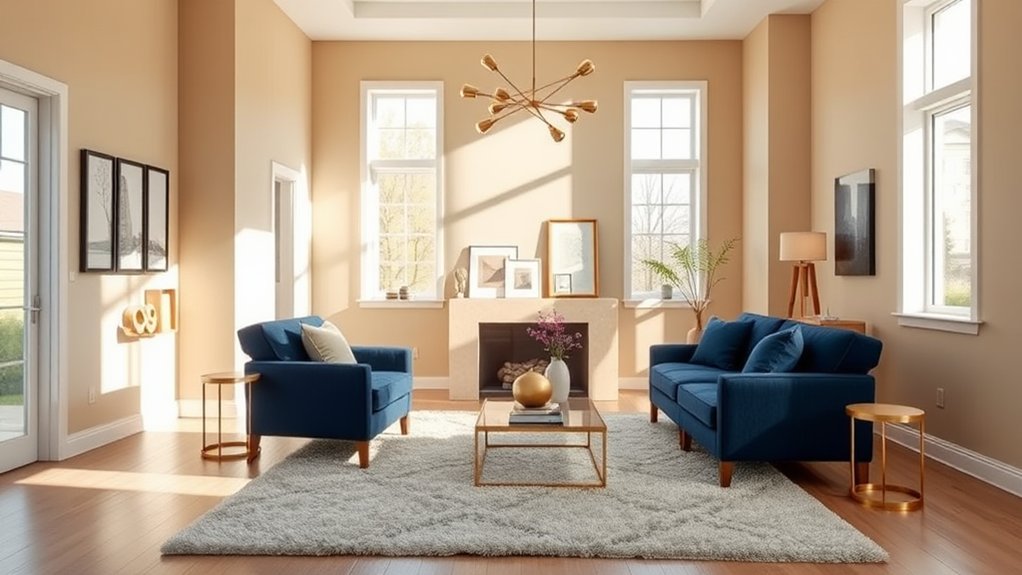
The 60-30-10 rule offers a sophisticated approach to color distribution in living room design, with 60% dedicated to a dominant primary color that establishes the room's foundation.
Secondary colors account for 30% of the space through furniture and textiles, while the remaining 10% introduces vibrant accent pieces that create visual intrigue.
This balanced color ratio guarantees a cohesive aesthetic that feels both intentional and professionally curated, preventing any single color from overwhelming the space.
Popular choices for dominant colors include earthy tones and pastels that nurture warmth and serenity in the living space.
Primary Color Dominates Space
Successfully creating a harmonious living room color scheme relies on the time-tested 60-30-10 rule, where a primary color commands approximately 60% of the visual space.
This dominant hue, typically applied to walls and large furniture pieces, establishes the room's fundamental color harmony and sets the overall room atmosphere. Choose this primary color carefully, as it forms the foundation for all other design elements.
Accent Colors Add Interest
Building upon the primary color foundation, accent colors bring dynamic visual interest to your living room through the remaining 30% and 10% portions of the color scheme.
Following interior design principles, the secondary color (30%) appears in furniture pieces and substantial decor, while the accent color (10%) provides vivid pops through accessories. This color theory approach creates a sophisticated, balanced composition without overwhelming the space.
Balance Creates Visual Harmony
Creating visual harmony in your living room relies on the time-tested 60-30-10 rule, which professional designers use to achieve perfect color balance.
This color theory principle divides your space into proportions: 60% dominant color for walls and large surfaces, 30% secondary color for furniture and textiles, and 10% accent color for design elements like accessories and artwork.
This formula guarantees a cohesive, visually pleasing room.
Identify Your Focal Point
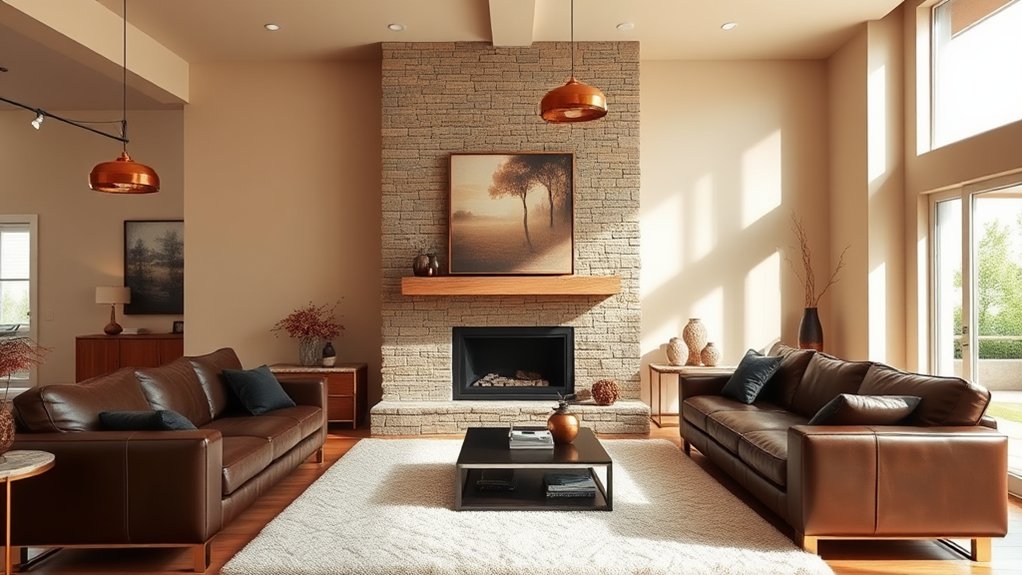
When selecting your living room color scheme, begin by identifying the space's focal point, whether it's architectural elements like a fireplace or large windows, or prominent furniture pieces that command attention.
A defining feature serves as an anchor for your color choices and helps establish visual hierarchy within the room.
Your focal point might also be an existing statement piece, such as an heirloom Persian rug or a striking piece of artwork, which can naturally guide your color palette selection.
Furniture or Architectural Features
Before selecting your living room colors, identify the dominant architectural features or key furniture pieces that will serve as focal points in your space.
These elements, whether a statement sofa, built-in shelving, or distinctive wall decor, establish visual anchors that influence your color scheme.
Consider how exposed beams, floor design patterns, or large windows can naturally guide your palette selection and create visual harmony.
Existing Room Statement Piece
A room's statement piece serves as the foundation for your entire color scheme, acting as a natural springboard for palette development.
Whether it's an heirloom Persian rug, a bold piece of artwork, or a designer sofa, let this focal point guide your color choices.
This approach prevents potential color clash and resolves the common design dilemma of where to begin when selecting living room hues.
Match Your Existing Furniture
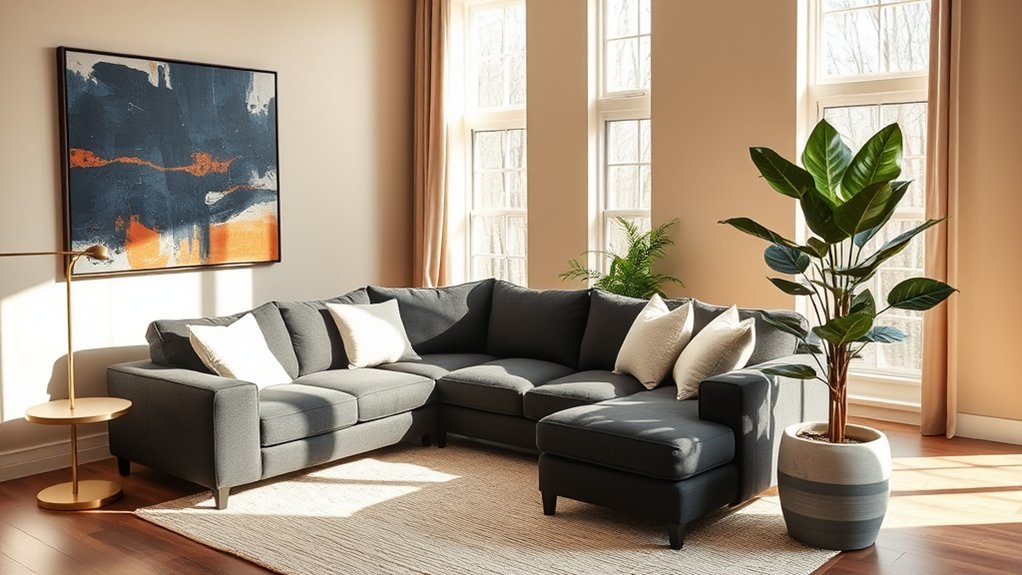
Selecting your living room color palette should begin with a careful assessment of your existing furniture pieces.
Your sofa, chairs, and major furnishings serve as foundational elements that influence your overall design direction. Consider both the furniture style and upholstery colors when developing your scheme. Deep navy sofas might suggest cool-toned walls, while warm leather pieces naturally complement earthy palettes.
Test Paint Samples
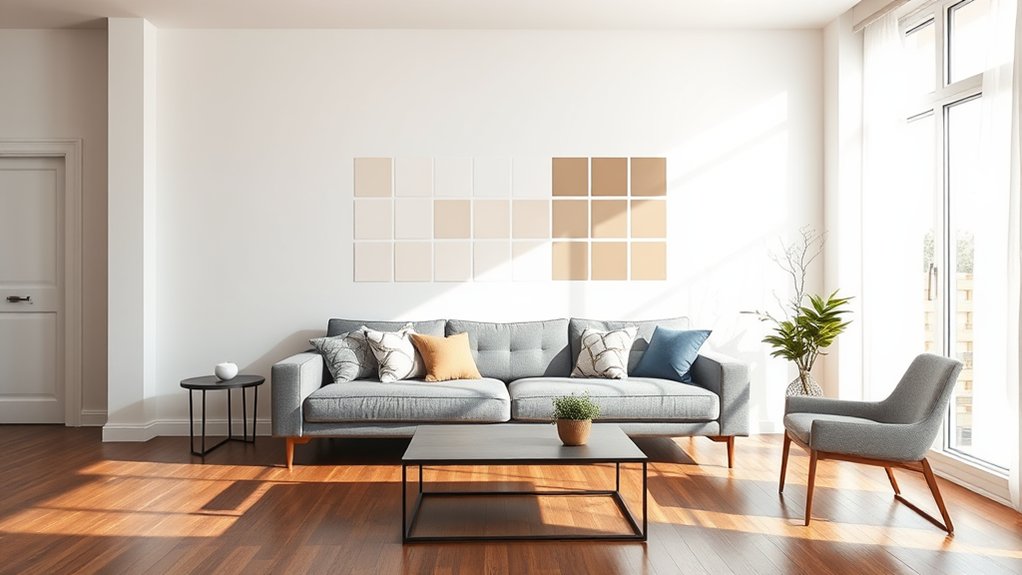
Testing paint samples is a vital step in selecting the perfect living room color scheme, as paint can appear dramatically different once applied to your walls.
For accurate color assessment, paint large swatches side-by-side and observe them throughout different times of day, paying attention to how natural and artificial lighting affects each shade. These generous sample areas will reveal undertones and subtle variations that might not be apparent on small paint chips, helping you make a confident final selection.
Paint Multiple Swatches Side-by-Side
Paint samples deserve more than a fleeting glance in store lighting – they need careful evaluation directly on your living room walls.
Place multiple swatches side-by-side to compare undertones and observe how color trends translate in your space.
Paint generous squares of each sample, spacing them slightly apart.
View these patches throughout the day as natural light shifts, revealing true color characteristics.
Test Different Lighting Conditions
After applying your paint samples, observe them under various lighting scenarios to fully understand their true appearance.
Natural daylight, artificial overhead lighting, and evening shadows can dramatically affect color variation throughout the day.
Evaluate samples during morning, afternoon, and night to guarantee the color maintains its desired impact.
Consider seasonal lighting effects and how window placement influences the room's ambiance.
Compare Large Sample Areas
While observing colors under different lighting conditions provides valuable insights, small paint swatches alone cannot tell the full story.
For accurate color comparison, paint large test patches of at least 2×2 feet on multiple walls. This expanded swatch testing allows you to properly evaluate how each shade impacts the room's ambiance, interacts with furnishings, and flows with adjacent spaces.
Study Color Psychology

Colors profoundly influence our emotions, behavior, and overall well-being in ways that interior designers have long understood.
Each hue carries distinct color meaning and emotional impact – blues promote tranquility, yellows stimulate conversation, greens create balance, and reds energize spaces. Understanding these psychological effects helps create living rooms that align with your desired mood and support your lifestyle goals.
Draw From Your Art Collection
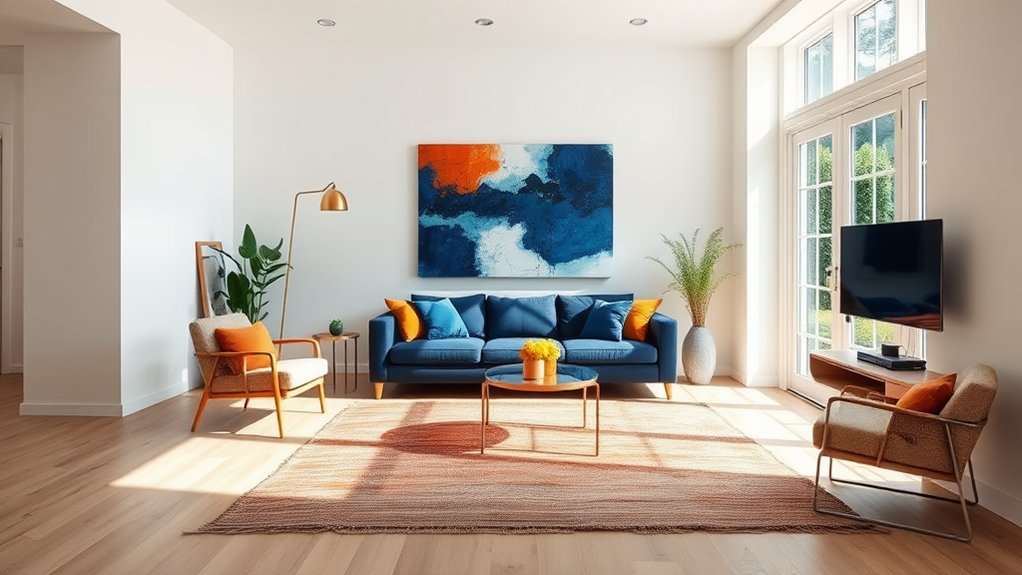
Your existing artwork can serve as a natural springboard for selecting your living room's color palette.
Analyze the dominant hues and subtle undertones in your favorite pieces to establish a cohesive theme.
Your art collection reflects your personal style, so incorporating these colors into walls, furnishings, and accessories creates an authentic, curated space that harmoniously showcases your artistic preferences.
Follow Color Wheel Principles

Understanding color wheel principles provides a scientific foundation for creating harmonious living room color schemes.
For ideal color harmony, consider using complementary colors (opposite on the wheel) for dramatic contrast, or analogous colors (adjacent) for subtle sophistication.
When crafting your palette creation, triadic color schemes offer balanced visual interest while split-complementary arrangements provide refined contrast with less tension.
Account for Room Size

Room dimensions play a crucial role in color selection, as spatial perception is directly influenced by color choices.
Lighter shades expand visual space, making them ideal for compact areas, while darker tones create intimacy in larger rooms.
Consider room layout and furniture arrangement when selecting colors – darker accent walls can define zones effectively, while consistent light tones maximize the perception of openness.
Factor in Ceiling Height
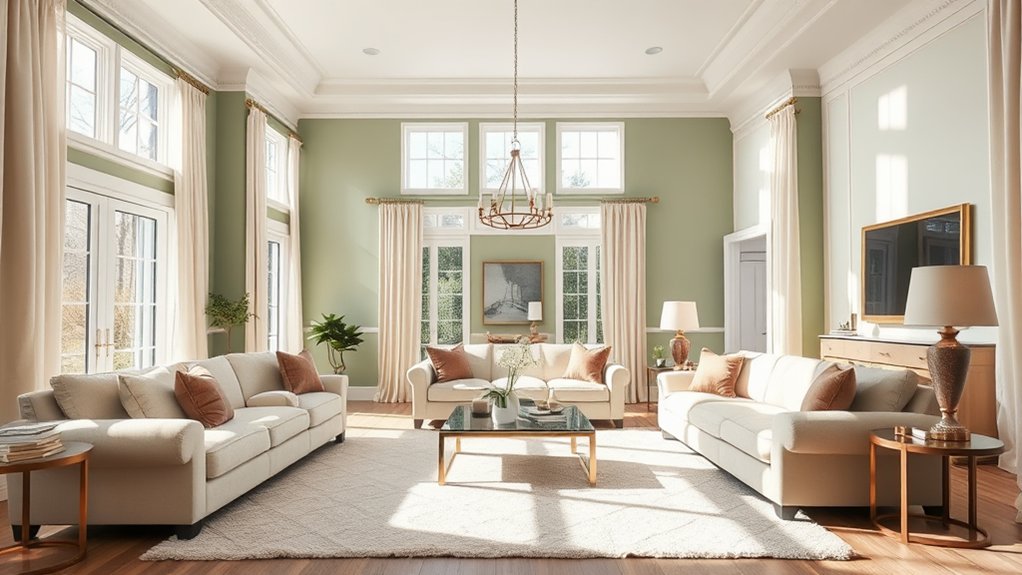
Much like the horizontal dimensions of a space, ceiling height substantially impacts color selection strategy.
Low ceilings benefit from lighter shades that create an illusion of height, while vertical stripes can enhance the perception of room height.
Conversely, high ceilings may require darker or warmer tones on the upper walls to visually lower the space and maintain a cozy, intimate atmosphere.
Balance Warm and Cool Tones
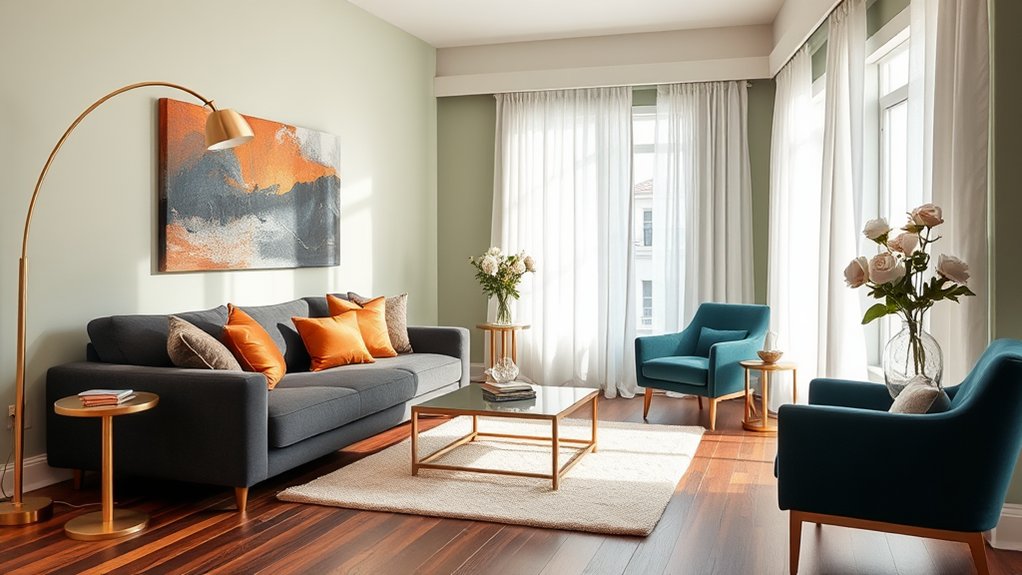
Achieving harmony in living room design requires thoughtful distribution of warm and cool tones to create seamless visual temperature shifts throughout the space.
Strategic placement of complementary colors, such as pairing rich terracottas with serene blues or sage greens with warm golds, establishes a sophisticated balance while preventing any single temperature from dominating.
Create Visual Temperature Flow
In any well-designed living room, the interplay between warm and cool tones creates a sophisticated visual temperature flow that guides the eye throughout the space.
Strategic color schemes establish natural pathways, leading from warmer accent walls to cooler, restful areas.
This visual temperature control helps define distinct zones while maintaining harmony, allowing each area to shift seamlessly into the next.
Blend Opposite Color Groups
Color mastery in living room design hinges on the strategic blending of opposing color groups, where warm and cool tones work in concert to create a balanced atmosphere.
Successful palette creation involves pairing vibrant oranges or reds with calming blues or greens, while maintaining visual harmony. These intentional color combinations prevent spaces from feeling either too energetic or overly subdued.
Define Room's Energy Zones
Through strategic zoning, living rooms can be divided into distinct energy areas using warm and cool color placements.
Space planning with color temperatures creates purposeful zones – warm reds and oranges for social gathering spaces, while cool blues and greens define relaxation areas. This intentional color mapping helps establish clear activity zones while maintaining visual harmony throughout the room's design.
Consider Seasonal Changes
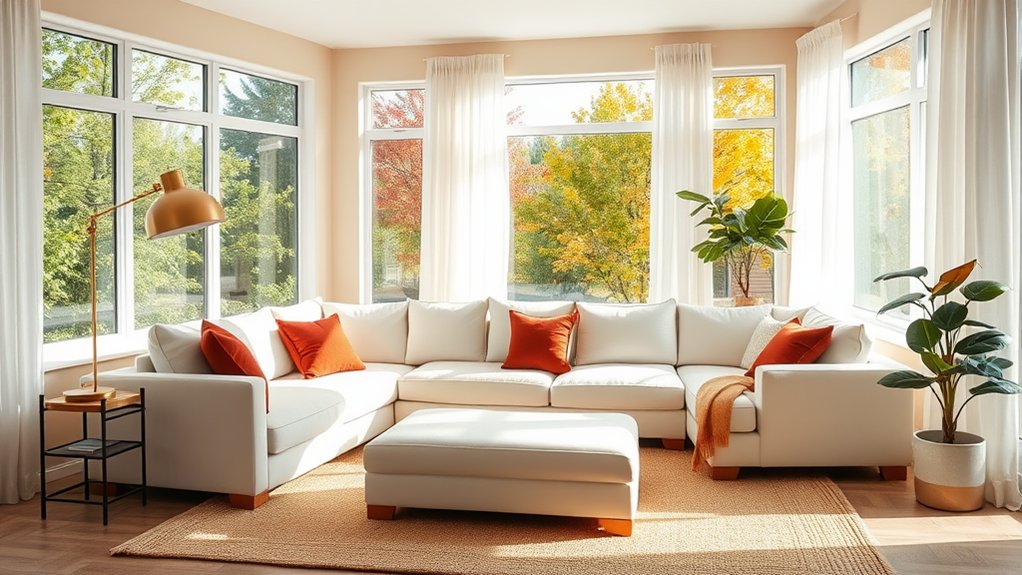
Seasonal shifts dramatically influence how paint colors appear in your living room throughout the year.
Natural lighting changes affect wall tones differently from summer to winter, while seasonal hues outside your windows create varying color reflections indoors.
When selecting paint colors, consider how current color trends complement your space across all seasons, particularly during times you use the room most.
Evaluate Architectural Features
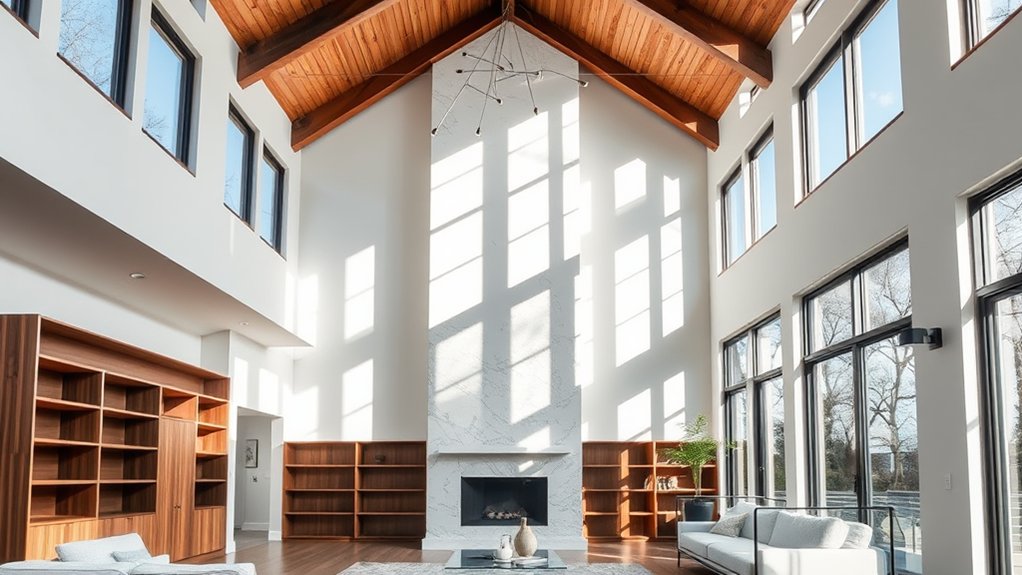
Architectural elements in your living room serve as critical foundations for your color selection process.
Consider how your home's architectural style influences color harmony – from rustic exposed beams to modern minimalist lines. Existing building materials like stone fireplaces, hardwood trim, or exposed brick establish natural color cues that should guide your palette choices for a cohesive design aesthetic.
Define Your Design Style
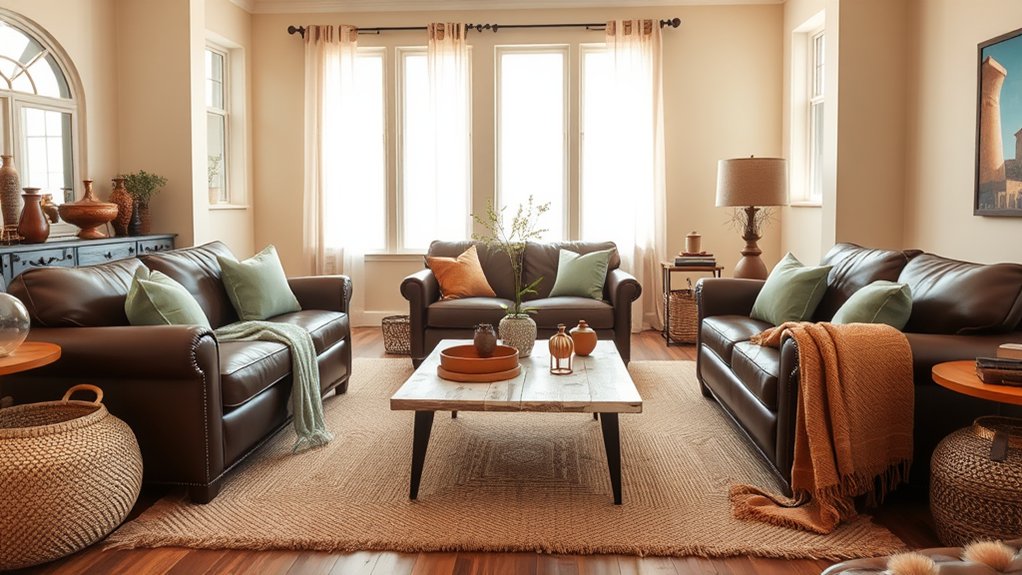
Identifying your preferred design style sets the stage for selecting the perfect living room color palette.
Whether you gravitate toward modern minimalism, classic traditionalism, or eclectic bohemian aesthetics, your design inspiration should reflect authentic personal expression.
Consider creating a mood board featuring images, textures, and color swatches that resonate with your chosen style direction and aesthetic preferences.
Learn From Color Trends
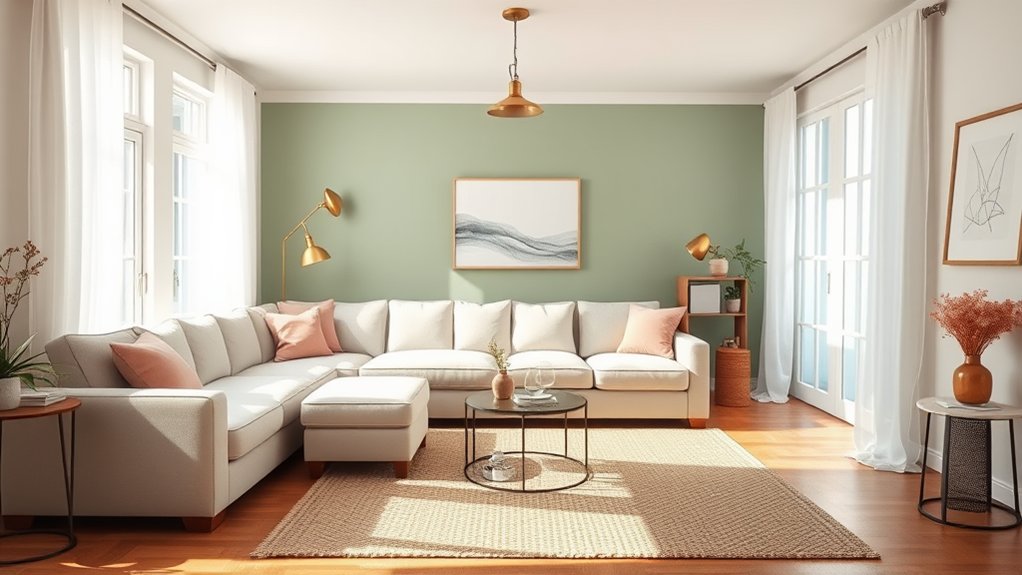
Color trends evolve each year, guided by industry experts, interior design forecasts, and shifting cultural influences.
While you shouldn't blindly follow every trend, they can provide valuable design inspiration for your living room palette. Current color trends often reflect broader societal moods and can help you discover fresh combinations or innovative ways to use classic hues in contemporary settings.
Incorporate Pattern Elements
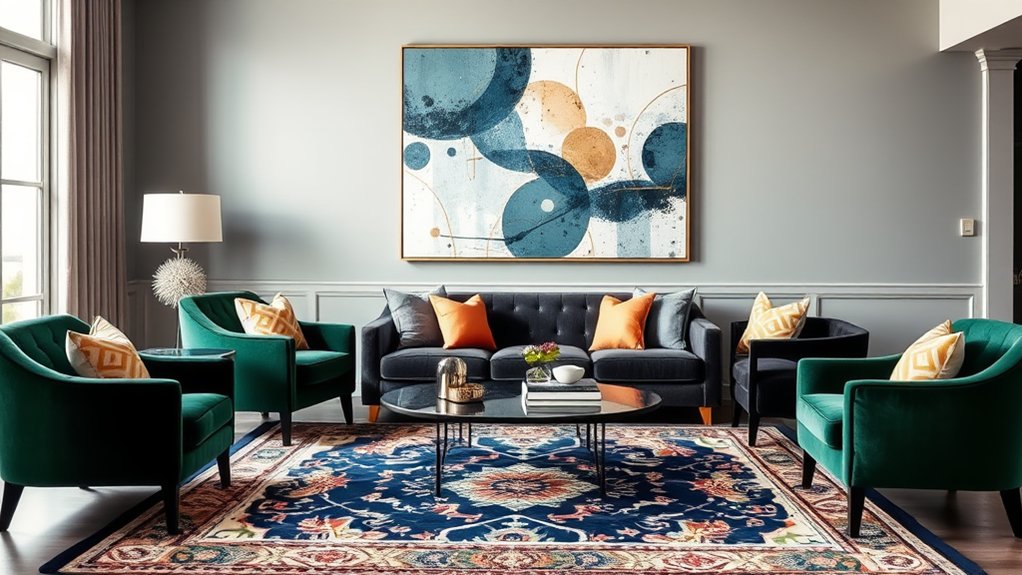
Pattern elements bring depth and visual interest to your living room's color scheme, transforming flat expanses into dynamic spaces that capture attention.
Consider incorporating geometric patterns through accent pillows, area rugs, or wallpaper to establish rhythm and movement.
Floral motifs can soften angular furniture while introducing complementary colors.
Layer these patterns strategically, maintaining a balanced hierarchy of scale and color intensity.
Assess Adjacent Room Colors
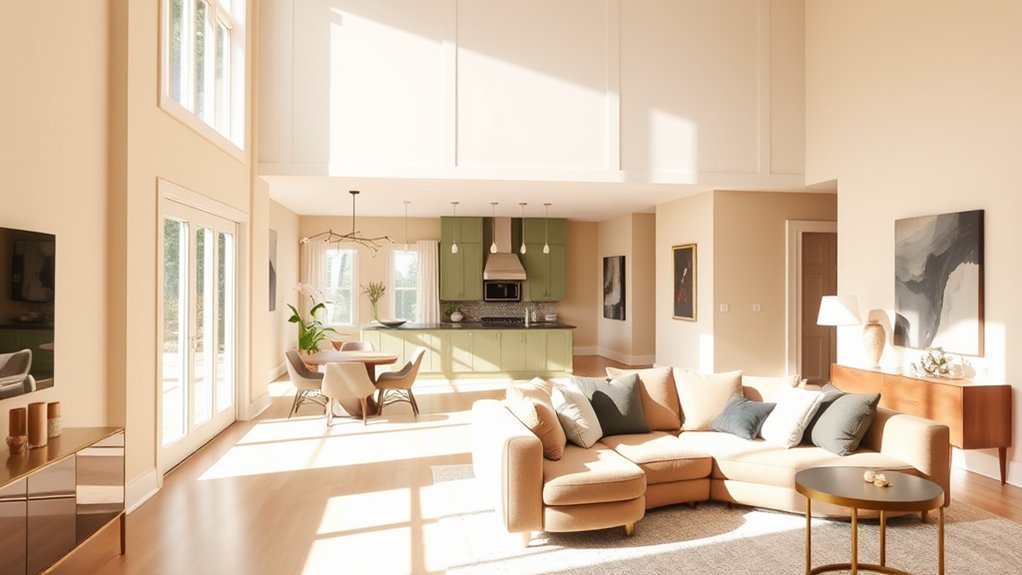
The visual harmony of your living room extends beyond its four walls, making it essential to think about the colors of connecting spaces.
Consider the color schemes of adjacent rooms to maintain room cohesion throughout your home. Create smooth shifts between spaces by selecting complementary or coordinating hues that flow naturally from one area to the next, ensuring color harmony across your entire floor plan.
Plan for Artificial Lighting
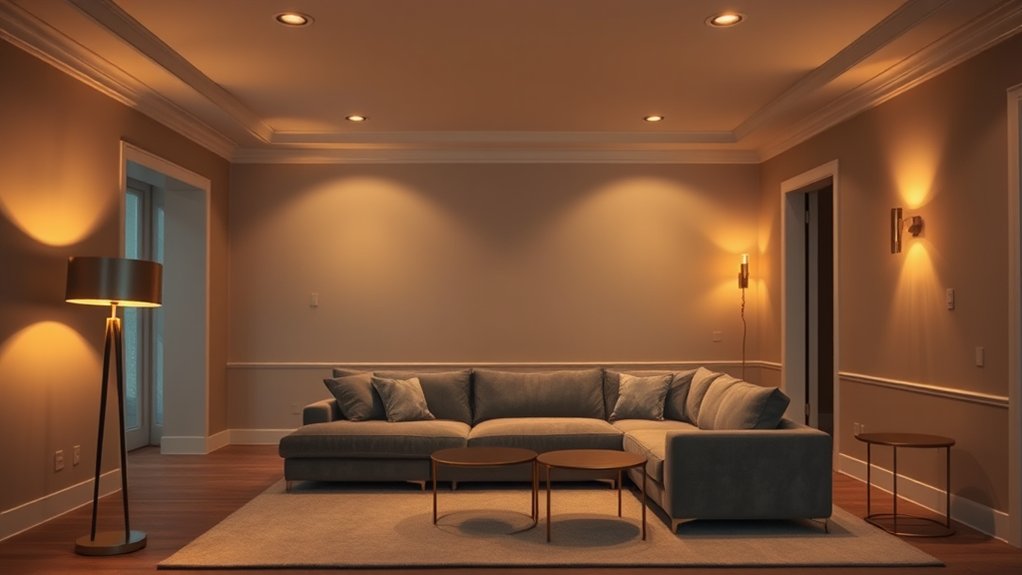
Artificial lighting can dramatically alter how paint colors appear in your living room throughout the day and evening.
When selecting your color palette, test paint samples under various lighting schemes, from bright overhead fixtures to subtle accent lighting.
Consider how different lamp options, such as wall sconces, floor lamps, or table lamps, will interact with your chosen colors during nighttime hours.
Remember Color Undertones
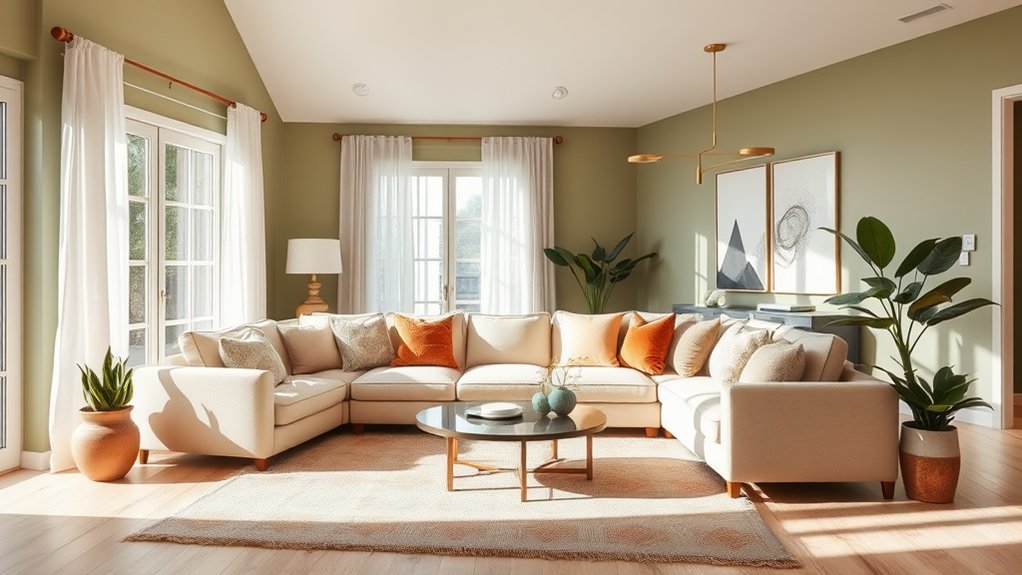
Understanding color undertones is crucial when selecting living room paint colors, as these subtle hues beneath the primary color can substantially impact your overall design scheme.
Through careful undertone analysis, you can identify whether a paint has warm, cool, or neutral base notes. Color theory teaches us that these underlying tones will either harmonize or clash with existing furniture and decor elements.
Review Fabric Selections

Reviewing fabric selections forms a natural extension of undertone analysis, as textiles play a major role in establishing your living room's color palette.
When evaluating upholstery, drapery, and decorative pillows, consider both current fabric trends and timeless options.
Select swatches that complement your chosen color scheme while ensuring harmony between patterns, textures, and solid colors throughout the space.
Consider Room Function
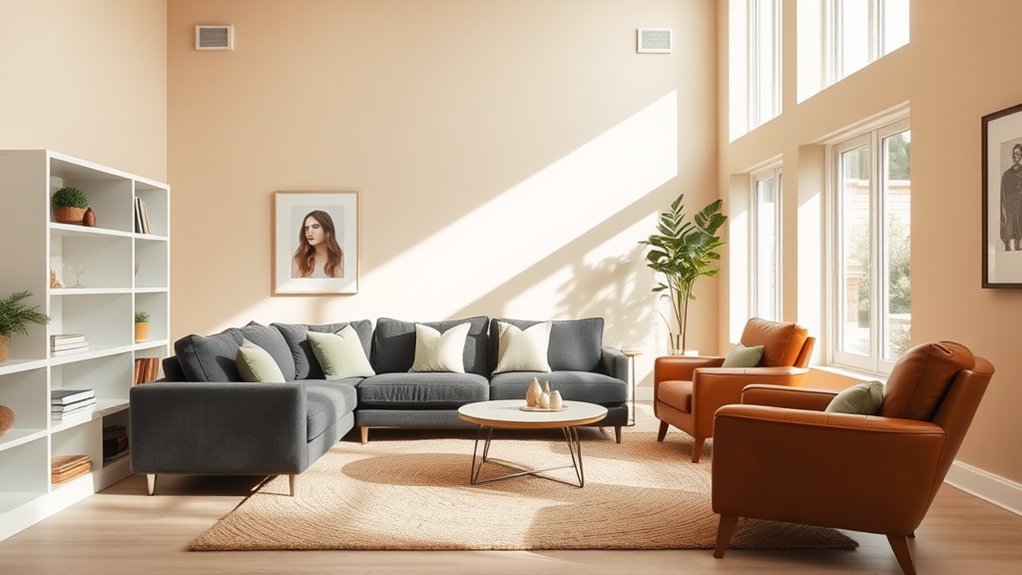
Your living room's intended purpose should guide your color selection process, as different activities call for distinct atmospheric qualities.
When space planning, consider if your room functions primarily as an entertainment hub, requiring energetic tones, or serves as a relaxation sanctuary, demanding softer hues.
The room purpose determines whether to choose stimulating or calming color schemes that support your lifestyle needs.
Embrace Personal Preferences
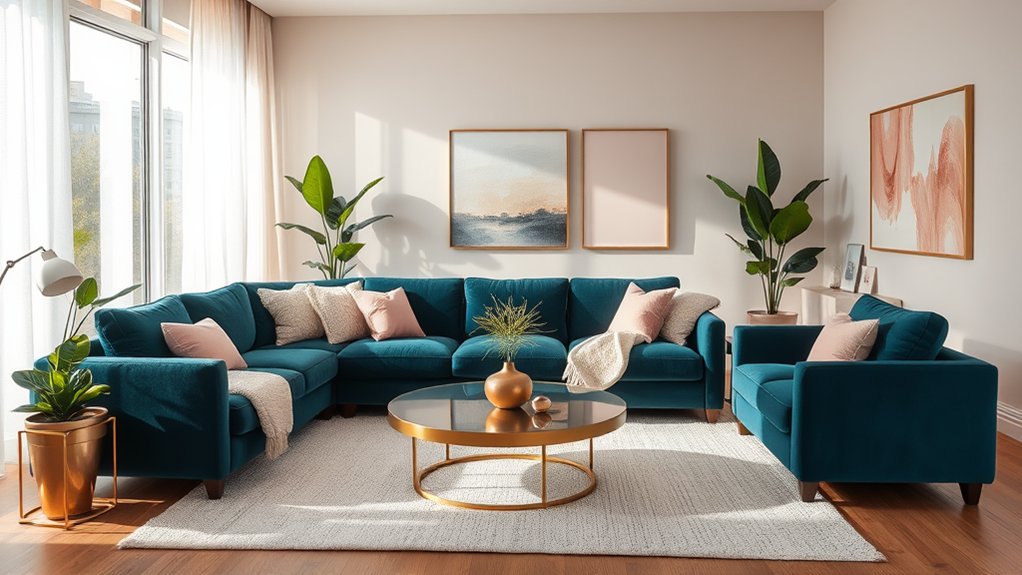
While design trends and color theory offer valuable guidance, your personal color preferences should be the foundation of your living room's palette.
The colors that resonate with you emotionally and aesthetically will create a space that feels authentically yours, reflecting your unique style and vision.
Trust your instincts when selecting hues that spark joy and inspiration, as these choices will ultimately craft a living room environment where you feel most at home.
Trust Your Color Instincts
Interior design experts consistently emphasize one fundamental truth: personal color preferences should guide your living room palette choices.
While color theory provides valuable guidelines, trusting your instincts often leads to more satisfying results.
Your personal taste naturally gravitates toward hues that reflect your personality and create comfort.
These intuitive choices typically result in spaces where you feel most authentically at home.
Follow Your Design Vision
Authenticity shines through when homeowners fully embrace their unique design preferences rather than strictly adhering to current trends.
Whether drawn to bold jewel tones or soothing neutrals, your personal style should guide your color choices.
Design inspiration can come from favorite artwork, cherished textiles, or meaningful places, creating a living room that genuinely reflects your aesthetic vision and lifestyle.
Maintain Color Flow
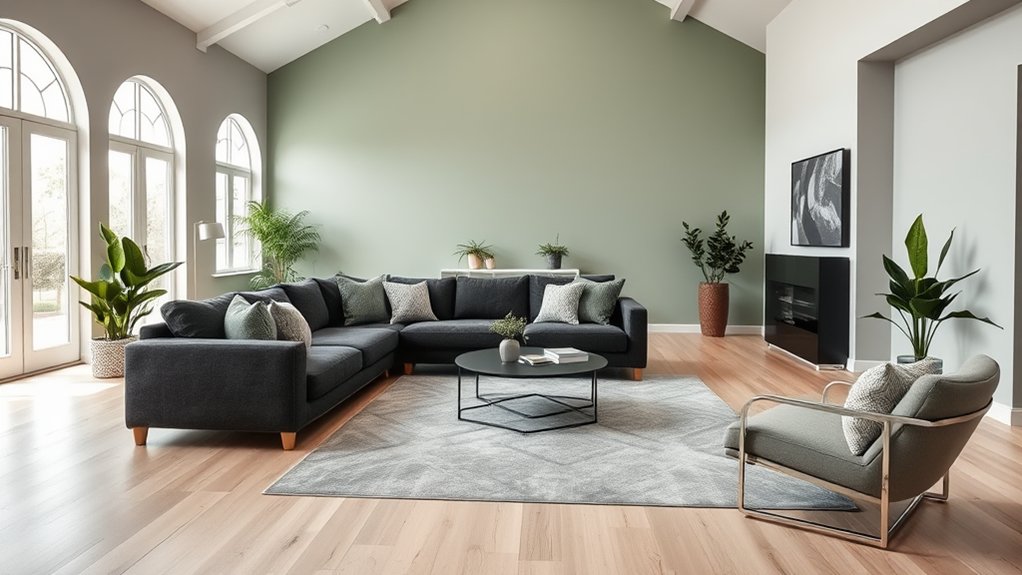
Creating a seamless color flow between your living room and adjacent spaces guarantees a cohesive, harmonious home design.
Achieve color harmony by selecting complementary or analogous hues that shift smoothly from room to room.
Maintain flow continuity by incorporating accent colors from neighboring spaces through decorative elements, textiles, and artwork, ensuring each room feels connected while retaining its distinct character.
Create Color Transitions
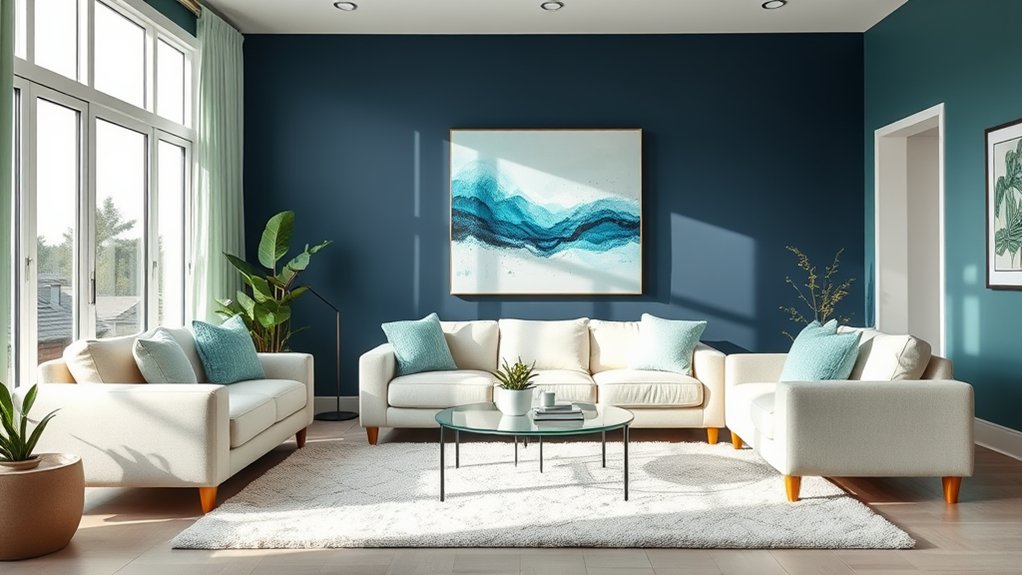
Creating seamless shifts between rooms requires thoughtful color blending to maintain visual harmony throughout your home.
Adjacent spaces can be unified by incorporating accent colors from one room into the next through textiles, artwork, or decorative elements.
Layering different tones of your chosen colors helps create depth and guarantees a sophisticated flow between living areas, making each space feel distinct yet connected.
Blend Adjacent Room Colors
Successful color shifts between connected rooms create a harmonious flow throughout your home, making spaces feel cohesive and thoughtfully designed.
When selecting color schemes for adjacent spaces, incorporate elements from neighboring rooms through accent pieces, textiles, or artwork. Consider using lighter or darker variations of the same hue to maintain room cohesion while allowing each space to retain its distinct character.
Layer Tones Between Spaces
Smooth color shifts between spaces establish visual continuity and guide the eye naturally from room to room.
Create gradual shifts by layering complementary tones that bridge adjacent areas. For example, if your living room features deep blues, incorporate lighter blue accents in connecting spaces. This thoughtful color palette progression guarantees room cohesion while maintaining distinct identities for each area.
Frequently Asked Questions
How Long Should I Wait Before Repainting My Living Room Walls?
Interior walls typically maintain ideal paint duration for 5-7 years, though color longevity depends on environmental factors, wear patterns, and paint quality. Consider repainting when surfaces show fading or visible wear.
Can I Mix Metallic Finishes With My Chosen Color Scheme?
Holy guacamole, mixing metallic accents can totally work! Modern design embraces blending gold, silver, and copper finishes, provided they complement your existing color combinations and maintain visual harmony throughout the space.
Will Certain Colors Affect My Home's Resale Value?
Color trends substantially impact resale value, with timeless neutral palettes typically offering the strongest return on investment. Bold color choices may limit buyer appeal, while sophisticated neutrals maintain broad market attractiveness.
How Do I Remove Stubborn Paint Samples From My Walls?
Effectively remove paint samples using gentle paint removal techniques like rubbing alcohol or vinegar solution. For stubborn spots, carefully sand the area and patch with spackling before applying wall prep methods.
Should My Living Room Color Match My Home's Exterior Colors?
While birds match their feathers, your living room colors needn't mirror exterior tones exactly. Subtle color harmony and exterior influence can create sophisticated flow, but interior spaces deserve their own distinct personality.
Conclusion
Color selection fundamentally shapes living room aesthetics and functionality, with research indicating that 85% of consumers cite color as the primary reason for purchasing decisions in home décor. Strategic implementation of the 60-30-10 rule, coupled with careful consideration of natural light patterns, creates balanced, harmonious spaces. Through methodical color shifts and adherence to design principles, living rooms can achieve both visual cohesion and personal expression while maintaining professional sophistication.

